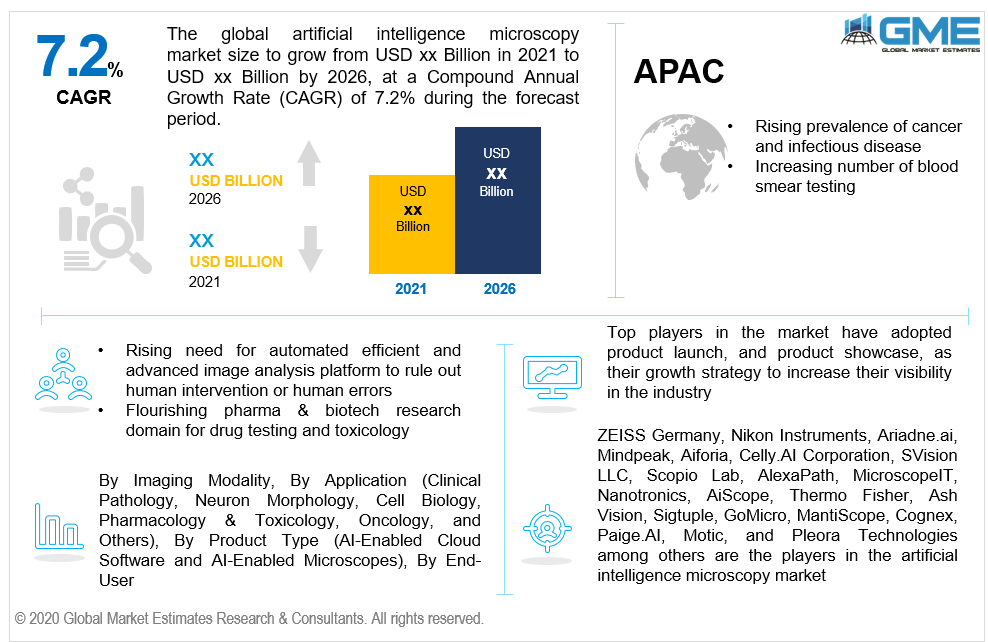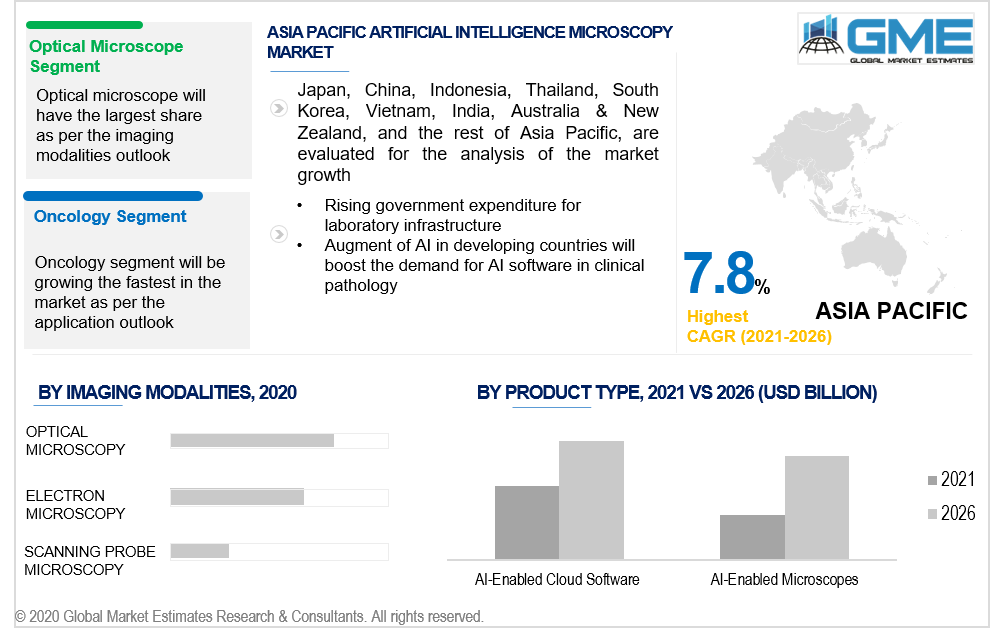
Global Artificial Intelligence Microscopy Market Size, Trends & Analysis - Forecasts to 2026 By Imaging Modality (Optical Microscopy, Electron Microscopy, and Scanning Probe Microscopy), By Application (Clinical Pathology, Neuron Morphology, Cell Biology, Pharmacology & Toxicology, Oncology, and Others), By Product Type (AI-Enabled Cloud Software, and AI-Enabled Microscopes), By End-User (Hospital Laboratories, Independent & Private Laboratories, Academic Research Labs, Pharmaceutical & Biotechnology Laboratories and Contract Research Organizations),Competitive Landscape, Company Market Share Analysis, and Competitor Analysis
Many companies and manufacturers across the globe are keenly involved in the process of developing and launching innovative artificial intelligence (AI) based software, devices, instruments, and equipment for the healthcare industry. One such innovation is AI-enhanced microscopy or AI-based software that can be aligned with the laboratory workflow and microscopy. AI and image analysis software are prime tools for scientists and pathologists who study live cells in setups like pathological labs, CROs, hospital labs, clinical labs, and academic centers. The AI microscopy is known to be formed on the cloud-based technology platform in order to offer advanced image analysis and streamline workflow.The major reason for the augment of AI in microscopy techniques is to wave off or replace the use of fluorescence dyes and markers on the live cells which are subjected under the microscope. Moreover, the use of AI-based software has helped the users to solve issues related todust on the sample, low contrast, imperfect image (and hence causes human-based error in analysis), and condensation artefacts among others. Such softwarecan detect the live imaging cells and tissues and form patterns and algorithms, to form an efficient analysis workflow that helps the user understand more easily. This software classifies the algorithmic pattern intelligently at a very high resolution with minimal human interference and user training. Besides, the analytical help, this software also offers features such as dynamic sharing of images on a cloud-based server (which can help other users to download), efficient and advanced whole slide imaging, and AI diagnostic support and services.This procedure used to be done manually in the early days. The most important features of such technology are precise image cell counting, screening for abnormalities and defects, seamless integration with lab workflow software, and cloud storage and cloud sharing capabilities. On the other hand, the market has also witnessed the augment or launch of AI-based microscopes.Such types of the microscope are a combination of robotics, computational super-resolution, optical microscopy, and artificial intelligence.Besides, sample defect detection is one of the features rendered by this technology. Major companies that have launched AI-enabled microscopes are Scopio Lab, Alexa Path, and AiScope, among others. The major application of this technology is cell biology, clinical pathology, neuron morphology, cell biology, pharmacology & toxicology, and oncology. The most common imaging modalities that are compatible with this software are the optical microscope, electron microscope, and scanning probe microscope.

Based on imaging modalities on which AI-based software is used are optical microscopy, electron microscopy, and scanning probe microscopy. Optical or light microscopy is estimated to be the largest segment as per market share or market revenue generation from 2021 to 2026. However, the electron microscopy segment will grow faster than the other two types, owing to the ability to generate high magnification live-cell images, widespread application areas inmaterial science, biology, nanotechnology, and semiconductor.
Based on the application of this market, the study can be segmented into clinical pathology, neuron morphology, cell biology, pharmacology & toxicology, oncology, and others. Oncology is the prime reason for the augmentation of AI in the clinical laboratory industry. Cancer disease diagnosis and prevention is the major driving factor for this segment to grow rapidly. Besides, clinical pathology will be the second-fastest-growing segment from 2021 to 2026.
Based on the type of product that renders artificial intelligence-based study results are AI-enabled cloud software and AI-enabled microscopes. The market has witnessed the presence and launch of AI-enabled cloud software more than the launch of AI-based microscopes. Hence, the market for the software will be dominant for a significant period i.e. from 2021 to 2026. However, the future of an AI-enabled or equipped laboratory is the AI-based microscope which will grow with the highest CAGR value during the forecast period.
Based on end-users for this market, the reported study can be split into hospital laboratories, independent & private laboratories, academic research labs, pharmaceutical & biotechnology laboratories, and contract research organizations. Based on the AI tool awareness and necessity for advanced image analysis, the market for independent & private laboratories will be dominant from 2021 to 2026. The second-largest segment was analyzed in the pharmaceutical and biotechnology laboratories owing to the rising trend in research activities related to drug toxicology and drug reaction testing.

As per the geographical analysis, the market can be classified into North America (the US, Canada, and Mexico), Asia Pacific (India, China, Japan, Malaysia, Singapore, and Rest of Asia Pacific), Europe (Germany, United Kingdom, Italy, France, Spain, Netherlands, and Rest of Europe), Middle East & Africa and Central South America.Owing to awareness, launch, and presence of AI-based companies and AI-based software in the U.S., the market for North America is ought to be the dominant one or have the lion’s share in the industry. However, due to rising cases of infection, an increasing number of blood smear testing, rising demand for advanced disease analytics, and the high prevalence of cancer in the Asian countries will help the Asia Pacific region to grow the fastest in the market.
ZEISS Germany, Nikon Instruments, Ariadne.ai, Mindpeak, Aiforia, Celly.AI Corporation, SVision LLC, Scopio Lab, AlexaPath, MicroscopeIT, Nanotronics, AiScope, Thermo Fisher, Ash Vision, Sigtuple, GoMicro, MantiScope, Cognex, Paige.AI, Motic, and Pleora Technologies among others are the players in theartificial intelligence microscopy market.
Please note: This is not an exhaustive list of companies profiled in the report.
In December 2019, Nikon Instruments launched NIS.ai, an AI-based software compatible with light or optical microscope.
We value your investment and offer free customization with every report to fulfil your exact research needs.
The Global Artificial Intelligence Microscopy Market has been studied from the year 2019 till 2026. However, the CAGR provided in the report is from the year 2021 to 2026. The research methodology involved three stages: Desk research, Primary research, and Analysis & Output from the entire research process.

The desk research involved a robust background study which meant referring to paid and unpaid databases to understand the market dynamics; mapping contracts from press releases; identifying the key players in the market, studying their product portfolio, competition level, annual reports/SEC filings & investor presentations; and learning the demand and supply-side analysis for the Artificial Intelligence Microscopy Market.

The primary research activity included telephonic conversations with more than 50 tier 1 industry consultants, distributors, and end-use product manufacturers.

Finally, based on the above thorough research process, an in-depth analysis was carried out considering the following aspects: market attractiveness, current & future market trends, market share analysis, SWOT analysis of the company and customer analytics.

Tailor made solutions just for you
80% of our clients seek made-to-order reports. How do you want us to tailor yours?
OUR CLIENTS